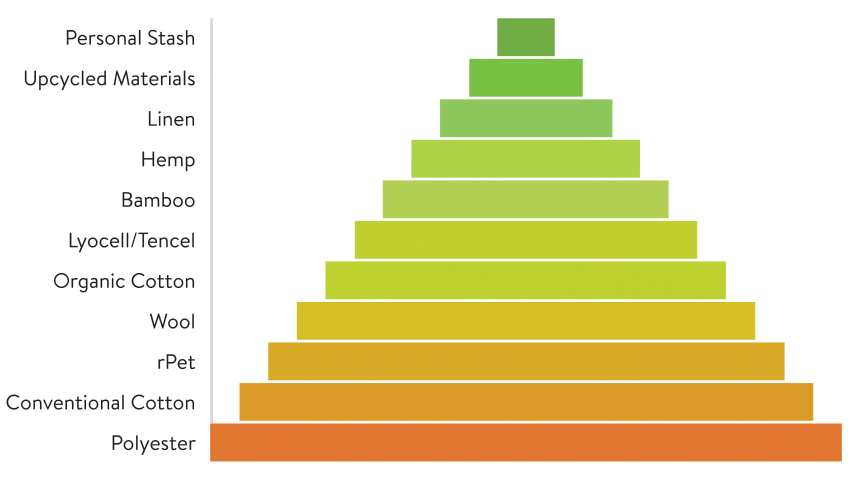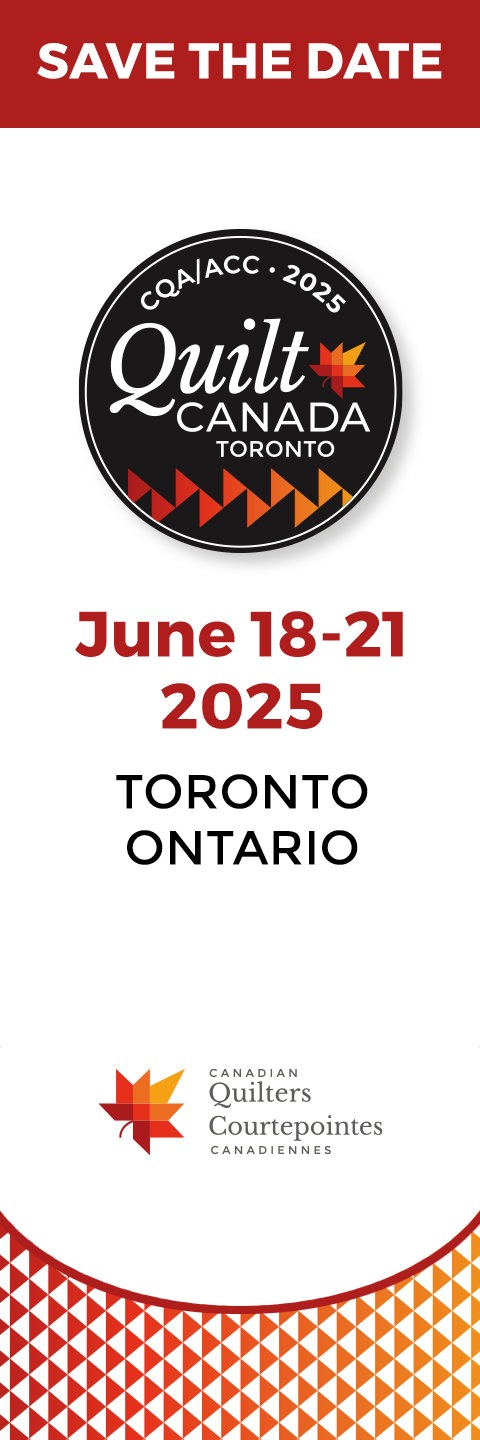THE RIGHT DECISION
One of the biggest challenges when creating with sustainability in mind is the stress behind making “the right” decisions.
In my opinion, there is no one right way to approach sustainability. What may be right for one person in one region with one particular socio-economic profile and unique interests, may not suit another.
You may also be at the beginning of your sustainability journey, just starting to make small changes (yay!). It can get overwhelming to think about this great big picture of harm to the planet from our favourite hobby; that’s a lot of responsibility.
The information and ideas that I share are for your consideration, something to think about. I am not suggesting anyone stop shopping entirely and ignore the beautiful textiles we have access to. Nor do I want to make anyone feel guilty about choosing materials and supplies, or for having a stash of fabric in their sewing room.
What I am asking—what I invite you to do—is to start selecting materials more mindfully; to consider the impact of those choices, and maybe change one thing in your practice, to reduce what we all buy.
Maybe that means shopping your own stash first—this is ideal! Maybe it means saving scraps and repurposing them later. Maybe it’s thrifting, upcycling, swapping, repurposing, and maybe it’s buying new-to-you, sustainably certified, and even the occasional conventional materials. Any of these options are reasonable, because the benefits we receive while creating—the impact the projects we are making have on our own and our communities’ mental health and well-being—outweigh the importance of always and only using sustainable material choices. Sometimes it’s just not feasible, and that’s okay.
THE WHY
We know the work we have to do—the “why.” The textile industry is one of the most water-intensive industries globally. Conventional cotton supplies almost 40% of the global fibre requirements and requires approximately 2,700 litres of water to produce just one cotton t-shirt and a pair of jeans. This excessive water usage puts a strain on freshwater resources, leading to water scarcity in many regions.
Conventional cotton cultivation also relies heavily on pesticides and chemical fertilizers, which not only harm the environment, but also pose health risks to farmers and workers. The chemicals used in textile production can leach into nearby water bodies, causing water pollution and adverse impacts on aquatic life. The expansion of cotton fields and other textile crops contributes to deforestation and land degradation. This loss of natural habitats negatively affects biodiversity and exacerbates the effects of climate change. It’s a long list of issues.
Fast fashion is an easy target for being the scapegoat in textile production. Fast fashion is the quick and constant production of cheap clothing that contributes to overconsumption, leading to excessive waste and pollution. It often involves the use of cheap materials and practices that may not be sustainable or ethically sourced. The pressure to keep up with rapid trends can also lead to exploitative labour conditions and has been proven to lead to harm to garment workers.
Quilting is a small part of this world, but it is not blameless. Our industry has been party to that kind of marketing and consumer encouragement over the years. Similar to clothing, there is always the next best thing, and marketing promotes scarcity which results in overproduction. Also, our tools are primarily made from non-recyclable plastics, and we have few options for recycling any of our supplies, making them likely to be headed to the landfill at the end of use.
Quilters have a leg up when it comes to reducing textile waste in the clothing industry. We’ve been creating with sustainable practices for centuries. We can repair damaged clothing to make it last longer, repurpose the fabrics into quilts instead of discarding old clothes, and we can make our own clothing from new and repurposed fabrics that will last for years and years (before finally being made into a that quilt!).
Incorporating minimalism and conscious consumption in textile choices is a powerful way to promote sustainability.
It involves being intentional with our purchases, focusing on quality over quantity, and selecting timeless, versatile materials that align with our values.
By practicing conscious consumption, we become more aware of the impact our textile choices have on the environment and society. This mindfulness helps us make informed decisions, supporting local, ethical and eco-friendly brands.
As consumers, we have enormous power in how the industry moves forward. When we purchase with intention, mindfully, we can ask for what we want, and the industry will deliver it. We are already seeing an increase in organic and rPet options in our fabrics and supplies like threads (well done!). Cloud9, Spoonflower, Aurifil, Gütermann, Sew Pure, Scanfil, Medeira and Mettler all carry sustainable options that can easily be brought into retail shops. Ask for it. We still need to see a change in the supplies and notions of our craft, recycled and sustainable options are limited. I always opt for local, artisan-tools when I can—they may cost more, but they support local economies and are quality vs quantity. The hand-turned, replaceable-blade seam ripper I have will be the last one I need to buy.
Let’s take a look at the possible things you can consider when you are wanting to start a project and you’ve decided this is the one that is going to be a sustainable project.
SHOP YOUR STASH AND UPCYCLE
The first option should always be to shop your own stash. Use what you have. We have all seen the memes like “Do not question the size of my fabric stash…unless you think it needs to be bigger” or “I have all the fabric I need…said no quilter ever”. These are designed to validate consumption and encourage consumerism; it’s clever marketing. But with conscious consumption, we can pause and be more selective in what we buy. We can purchase special fabrics for meaningful projects, and we can shop what we already have, what we have already considered to be special and create with intention.
If your stash doesn’t meet the needs of the project, the use of upcycled materials and clothing, utilizing deadstock, and repurposing fabrics, hold immense sustainability potential. By diverting textiles from landfills and extending their lifecycle, upcycled materials significantly reduce the environmental burden of textile waste. When we look at the types of materials we want to use in an up-cycled project, natural materials and polyesters both should be considered. Polyesters that are upcycled into quilt or home textile projects are saved from the waste stream, and the microplastics that are inherent in them are kept out of the soils and waterways.
NATURAL AND RENEWABLERESOURCES
In the pursuit of sustainable textile choices, the next step is to opt for natural and renewable fibres. These materials offer benefits for both the environment and the individuals who wear them. Natural fibres such as organic cotton, hemp, and linen are derived from plants and have a lower environmental impact compared to synthetic alternatives. Organic cotton, for instance, is grown without harmful pesticides and chemicals, reducing soil and water pollution while supporting healthier ecosystems. Hemp, a strong and durable fibre, requires minimal water and land to thrive, making it a sustainable choice.
Linen, crafted from the flax plant, not only has strength, durability, and is biodegradable, but also boasts excellent breathability.
In addition to natural fibres, it’s essential to explore renewable alternatives like bamboo and Tencel (lyocell). Bamboo is a highly renewable resource that grows quickly, without the need for pesticides or irrigation. Its fibres create soft and comfortable textiles with excellent moisture-wicking properties. Tencel, derived from sustainably sourced wood pulp, utilizes a closed-loop production process, where solvents are recycled, minimizing waste and environmental impact. These options are becoming more readily available in materials and threads from producers in the quilt industry.
OPT FOR ETHICAL ANDECO-FRIENDLY PROCESSES
It is crucial to be aware of the environmental implications of textile production processes. Conventional dyeing and finishing methods often involve the use of harmful chemicals and excessive water consumption, leading to pollution of water bodies and the emission of greenhouse gases. By choosing fabrics that undergo eco-friendly processes, we can minimize our ecological footprint and contribute to cleaner and safer ecosystems.
Here’s your chance to embrace the dyeing and printing techniques that you’ve always wanted to try; they are kinder to the environment. Eco-friendly dyeing involves using natural dyes sourced from plants, insects, or minerals, avoiding the release of harmful chemicals into the environment.
Digital printing, common in today’s on-demand runs from fabric manufacturers, reduces water waste and chemical usage compared to traditional screen-printing methods, so this is also a good option. By supporting these sustainable approaches, we help preserve biodiversity, safeguard water resources, and reduce our overall impact on the planet.
PRIORITIZE SUSTAINABLE CERTIFICATIONS AND STANDARDS
Certifications such as the Global Organic Textile Standard (GOTS) and OEKO-TEX play a crucial role in the textile industry. GOTS ensures that products meet strict organic standards, from harvesting raw materials to environmentally and socially responsible manufacturing processes.
OEKO-TEX, on the other hand, certifies that textiles are free from harmful substances. As responsible consumers, we can actively seek out products with recognized sustainable labels. By choosing items with GOTS, OEKO-TEX, or other reputable certifications, we support a supply chain that values ethical practices, minimizes environmental impact, and contributes to the greater good. Together, we create a demand for sustainable products, encouraging more brands to adopt eco-friendly practices.
SHOP LOCAL
Always check your local quilt shops before purchasing something online.
They often carry local and regional products, they employ your neighbours, and you can save money and the environment by reducing the impacts of shipping. Supporting your local community is a win-win.
SUPPORT LOCAL AND CIRCULAR ECONOMIES
Supporting local textile producers helps reduce the carbon footprint associated with transportation and fosters a closer connection between consumers and makers. By valuing locally sourced materials, we contribute to the economic growth of our communities while promoting sustainable practices.
In a circular economy, products are designed to be reused, repaired, or recycled, minimizing waste and resource consumption. By choosing to
buy second-hand or upcycled textiles, and recycling textiles at the end of their life, we contribute to a regenerative system where materials circulate rather than being discarded. This shift towards circular practices contributes to a more sustainable and resilient textile industry.
Although challenges like accessibility and cost exist, together, we can overcome them. Advocating for sustainable changes, supporting initiatives, and educating ourselves will lead us toward a more sustainable textile industry.
In the artistry and creativity of quilting, let’s also celebrate our role as stewards of the environment. By understanding the implications of different materials and production processes, we can navigate the path toward a more conscious and eco-friendly textile future. Each choice we make as individuals and as a community can steer us closer to a world where art and sustainability come together.

Materials selected based on sustainability criteria, which include: environmental impact, social considerations, resource efficiency, end-of-life options, and the reduction of textile waste.
You can find a directory of sustainable suppliers in The Green Stitcher’s Hive, where quilters and textile enthusiasts unite to explore sustainable choices and support each other’s eco-conscious journey. With a vibrant community of like-minded individuals, we delve into eco-friendly materials, ethical practices, and mindful consumption, all while creating beautiful and sustainable textile art. Check out Bridget’s website at www.bridgetoflaherty.com for more details.
Bridget O’Flaherty is a Canadian free-motion embroiderer, quilter and textile artist, teacher, speaker and podcaster with a decade of experience in the sustainable building industry. Known as The Sustainable Quilter, she shares her passion for the natural environment in her art and online community.
bridgetoflaherty.com
bridgetoflaherty.com/threads-of-sustainability-podcast/
@bridgetoflahertytextiles


